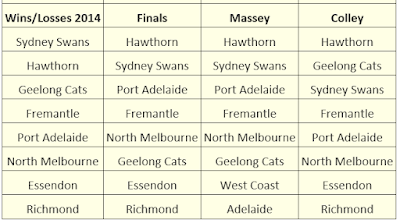On Udemy - March MATHness, based on the USA College Basketball knockout competition "March Madness".
and on Edx - Applications of Linear Algebra Part 1 - go to Unit 6.
He has also set up a website to rank the USA College men's basketball teams in "March Madness" - http://marchmathness.davidson.edu
USA Basketball and Football rankings are based on the methods detailed in this blog:
Most sports teams are ranked by the simple Win/Loss record or winning percentage. So a team that wins 7 out of 10 games (70%) has a higher ranking than a team that wins 4 out of 10 (40%) games.
However, this simple calculation does not take into account that each team can play different teams (conferences/strength of competition) or that teams do not play each other the same number of times (as in my favorite sport - Australian Rules Football (AFL) - "Oh when the SAINTS....").
Methods of Sports Ranking
Most sports teams are ranked by the simple Win/Loss record or winning percentage. So a team that wins 7 out of 10 games (70%) has a higher ranking than a team that wins 4 out of 10 (40%) games.
However, this simple calculation does not take into account that each team can play different teams (conferences/strength of competition) or that teams do not play each other the same number of times (as in my favorite sport - Australian Rules Football (AFL) - "Oh when the SAINTS....").
Methods of Sports Ranking
Each method uses High School Maths (linear algebra, matrices, least squares and network graphs), which makes these methods really useful to teach students and adds to the movement of "making Maths more relevant and interesting".
I will outline some class activities within the Colley and Massey page links (on the right).
As an introduction, the letters represent each team and we have 2 different conferences represented by the 2 different directed graphs, one starting with Team A and the 2nd conference starting with Team G.
The arrow pointing from Team A to Team B means Team A beat Team B. Also Team F (in the 2nd conference) beat Team D (in the first conference). So how would you rank these teams?
A range of activity cards could be made representing different sports competitions. A good activity would be to get students to create a directed graph of their favorite sports teams.
Following those simple directed graphs are the two most popular sports ranking systems that have been developed. Follow these links for the linear algebra involved -
1. The Colley Method is based on the strength of the teams you beat.
2. The Massey Method is also based on the strength of the teams you beat plus the score differential.
A Brief Look at This Method for Australian Football
A comparison of the different methods from previous AFL seasons are in the tables below. The "Finals" or playoff method was the eventual outcome, Massey predicted this more accurately than the other methods (a short 3-minute video on the "Sports Data and Software" page shows how this Massey ranking was obtained).
Massey has the current Australian Football rankings - https://www.masseyratings.com/aufl/ratings
Massey has the current Australian Football rankings - https://www.masseyratings.com/aufl/ratings





Thanks for sharing info.
ReplyDeleteOnline training